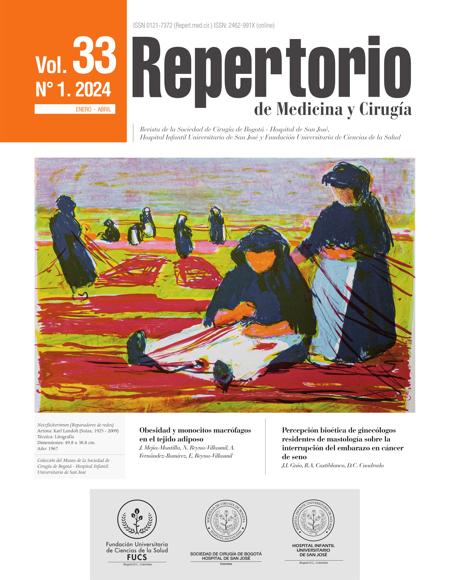Post-infarction ventricular septal defect: a devastating complication
Defecto septal ventricular postinfarto: complicación devastadora
![]()
![]()

Show authors biography
Introduction: ventricular septal communication is the most frequent mechanical complication of acute myocardial infarction (MI), especially if associated with ST-segment elevation, featuring a rate of around 0.21%, which increases in older patients with extensive defects and no reperfusion therapy. In patients with multivessel involvement and no collateral circulation; it is a catastrophic situation which carries a poor prognosis. Case reports: two patients admitted to a university hospital in Bogotá, with ST-elevation post-MI VSD, undergoing no early reperfusion, both in cardiogenic shock. The first patient had a torpid evolution and early mortality. The second patient underwent a VSD transcatheter repair 10 days after MI, determining significant periprocedural increase in the size of the septal defect, with greater hemodynamic instability and death.
Article visits 358 | PDF visits 337
Downloads
- Rodés-Cabau J, Figueras J, Peña C, Barrabés J, Anívarro I, Soler-Soler J. Communicación interventricular postinfarto de miocardio tratada en fase aguda mediante cierre percutáneo con el dispositivo Amplatzer. Rev Esp Cardiol. 2003;56 6):623–5. https://doi.org/10.1016/S0300-8932(03)76925-5 DOI: https://doi.org/10.1157/13048161
- Kamioka N, Lederman RJ, Greenbaum AB, et al. Postinfarction Ventricular Septal Defect Closure. Circ Cardiovasc Interv. 2019;12(5):e007788. doi: 10.1161/CIRCINTERVENTIONS.119.007788. DOI: https://doi.org/10.1161/CIRCINTERVENTIONS.119.007788
- Assenza GE, McElhinney DB, Valente AM, Pearson DD, Volpe M, Martucci G, et al. Transcatheter closure of post-myocardial infarction ventricular septal rupture. Circ Cardiovasc Interv. 2013;6(1):59–67. doi: 10.1161/CIRCINTERVENTIONS.112.972711 DOI: https://doi.org/10.1161/CIRCINTERVENTIONS.112.972711
- Ruiz FA, Cadena A. Comunicación interventricular post infarto agudo del miocardio. Rev Colomb Cardiol. 2013;20(6):406–9. doi: 10.1016/S0120-5633(13)70094-9 DOI: https://doi.org/10.1016/S0120-5633(13)70094-9
- Rodríguez Jerez W, Preinfalk Lavagni G, Arauz Chavarría J. Ruptura del septum ventricular post infarto agudo del miocardio. Rev. costarric. cardiol. 2003;5(2):39-43.
- Elbadawi A, Elgendy IY, Mahmoud K, et al. Temporal trends and outcomes of mechanical complications in patients with acute myocardial infarction. JACC Cardiovasc Interv 2019;12(18):18251836.doi: 10.1016/j.jcin.2019.04.039 DOI: https://doi.org/10.1016/j.jcin.2019.04.039
- Goldsweig AM, Wang Y, Forrest JK, et al. Ventricular septal rupture complicating acute myocardial infarction: Incidence, treatment, and outcomes among medicare beneficiaries 1999-2014. Catheter Cardiovasc Interv 2018;92(6):1104-1115. doi: 10.1002/ccd.27576 DOI: https://doi.org/10.1002/ccd.27576
- Batts KP, Ackermann DM, Edwards WD. Postinfarction rupture of the left ventricular free wall: clinicopathologic correlates in 100 consecutive autopsy cases. Hum Pathol 1990;21(5):530-535. doi:10.1016/0046-8177(90)90010-3 DOI: https://doi.org/10.1016/0046-8177(90)90010-3
- Oliva PB, Hammill SC, Edwards WD. Cardiac rupture, a clinically predictable complication of acute myocardial infarction: report of 70 cases with clinicopathologic correlations. J Am Coll Cardiol 1993;22:720-726. doi: 10.1016/0735-1097(93)90182-z DOI: https://doi.org/10.1016/0735-1097(93)90182-Z
- Mann JM, Roberts WC. Acquired ventricular septal defect during acute myocardial infarction: analysis of 38 unoperated necropsy patients and comparison with 50 unoperated necropsy patients without rupture. Am J Cardiol 1988;62(1):8-19. doi: 10.1016/00029149(88)91357-4 DOI: https://doi.org/10.1016/0002-9149(88)91357-4
- Radford MJ, Johnson RA, Daggett WM Jr, et al. Ventricular septal rupture: a review of clinical and physiologic features and an analysis of survival. Circulation 1981;64(3):545-553.doi:10.1161/01.cir.64.3.545 DOI: https://doi.org/10.1161/01.CIR.64.3.545
- Birnbaum Y, Wagner GS, Gates KB, et al. Clinical and electrocardiographic variables associated with increased risk of ventricular septal defect in acute anterior myocardialinfarction. Am J Cardiol 2000;86(8):830-834. doi: 10.1016/s00029149(00)01101-2 DOI: https://doi.org/10.1016/S0002-9149(00)01101-2












